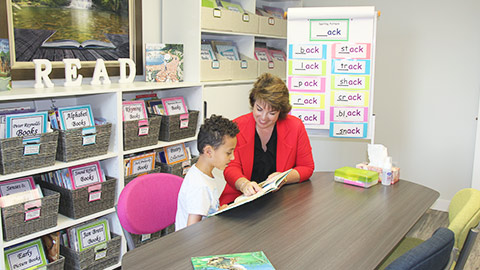
There are two basic aspects of skilled reading:
 The evaluation of reading ability focuses on various aspects of reading development including:
The evaluation of reading ability focuses on various aspects of reading development including:
Reading Perceptions and Attitudes
Reading perceptions, attitudes, and interests are important to reading development. Reading interviews provide insight about whether the learner understands the purpose of reading and how he/she feels about reading. It also explores the learner’s perception of his/her own reading ability and reading preferences. Personal perspectives and attitudes towards reading can significantly influence progress and development; namely, motivation and willingness to engage and persevere when reading tasks are challenging.
Word Recognition and Identification
Word recognition and identification are key aspects of reading development. Word recognition (or sight vocabulary) is the ability to accurately and automatically recognize words. Whereas, word identification is the ability to figure out unfamiliar words using decoding strategies (i.e., breaking words into smaller parts; examining the smaller parts of words for common letter and spelling patterns; using knowledge of sound-symbol correspondence to sound out and blend the different letter combinations and syllables into words) and/or context cues (i.e., considering the information provided in the reading material along with background knowledge to figure out words which make sense, and look and sound right in the context of the reading material). Ultimately, proficient word skills include both an extensive knowledge of sight words and the ability to employ strategies to decode unknown words.
Reading Rate and Fluency
Reading fluency is a fundamental characteristic of skilled reading. Typically, it is defined by several dimensions: accuracy, automaticity, rate, and prosody. Accuracy entails the recognition, identification, and pronunciation of written words and is calculated as the percentage of words read correctly on the graded oral reading passages. Automaticity is the efficiency of word recognition with little effort or cognitive demand (i.e., sight words). Rate is the speed or flow of reading connected text typically measured as the number of words read per minute on the graded oral reading passages. Finally, prosody focuses on how words are combined into meaningful phrases (i.e., intonation, inflection, expression, pitch, loudness, tempo, and rhythm patterns of spoken language to imply the meaning of the text). The four aspects of fluent reading are interrelated and integral to text comprehension, or the construction of meaning from text, which is the primary goal of reading. A key component of a reading assessment involves a comprehensive analysis of oral reading miscues or deviations from the text (i.e., word substitutions, insertions, omissions, repetitions, hesitations, sentence structure modifications, appeals for help, and self-corrections). Oral reading performance is carefully examined for patterns of behaviour in order to establish the learner’s current profile of strengths and challenges in reading.
It is important to keep in mind that word recognition is only one part of the reading process. Proficient word recognition does not automatically guarantee comprehension. Comprehension is another complex literacy skill which relies on a range of higher-level thinking and reasoning beyond the ability to merely read and process words in a printed text.
Reading Comprehension
Comprehension is the primary goal of reading. It is the ability to construct meaning and understanding from printed text. The evaluation of the learner’s comprehension skills is based on responses to pre-reading questions, passage retelling and think-aloud, as well as responses to literal and inferential comprehension questions for selected graded passages. The evaluation of reading comprehension focuses on the learner’s understanding and interpretation of both narrative and expository passages read orally and silently.
The comprehensive reading assessment at the Diagnostic Reading Centre of Calgary uses multiple measures to examine the component skills and processes associated with each aspect of reading in order to identify particular areas of proficiency and/or difficulty.
In turn, the remediation plan considers each individual’s learning profile in order to provide targeted instruction and guided practice on the particular reading skills and strategies needing further development using selected print materials at an appropriate developmental level.
